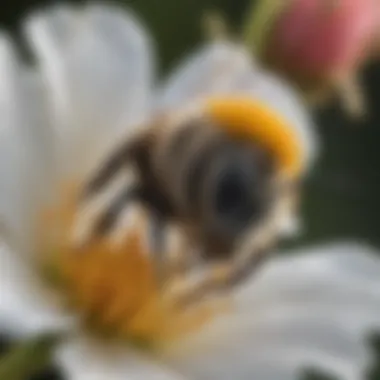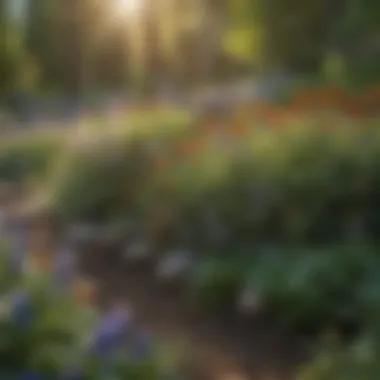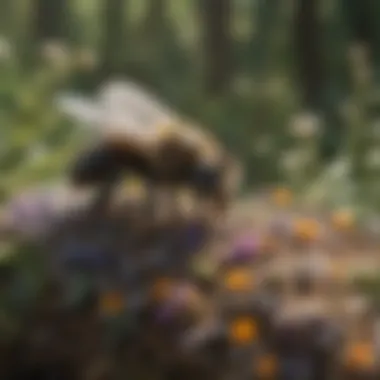Understanding Mason Bee Food for Conservation


Intro
Mason bees are essential pollinators, playing a significant role in the health of our ecosystems. Understanding their dietary needs is crucial for their preservation and the overall success of pollination efforts. This article is designed to delve into the intricacies of mason bee food sources. We will explore the types of food required for their survival, the environmental factors that influence food availability, and actionable measures to support their populations. The objective is to promote an informed perspective on sustaining these vital creatures.
Overview of Mason Bee Food
Mason bees are primarily solitary bees, relying on a diverse array of pollen and nectar from flowering plants. Their nutritional intake is critical not only for individual survival but also for the vitality of the entire colony. They typically gather food during the spring months when flowers are abundant.
Key food sources for mason bees include:
- Pollen: The primary protein source, rich in nutrients necessary for growth and reproduction.
- Nectar: Provides carbohydrates that supply the energy needed for daily activities, such as foraging and nest building.
The availability of these food sources is impacted by several factors, including climate change, habitat destruction, and agricultural practices. The decline in flowering plants directly correlates with a decrease in mason bee populations.
Importance of Food Sources
The success of mason bees is intricately linked to the types and diversity of flowers in their surroundings. Research indicates that mason bees tend to have preferences for specific plants based on their life cycles and resource needs.
"Mason bees show higher foraging efficiency on native flowers, underscoring the importance of preserving natural habitats."
Flowering plants beneficial to mason bees include:
- Willow (Salix): Blooms early in spring, providing nectar and pollen during a critical time.
- Fruit trees: Such as apple and cherry, which are not only vital for bees but also significant for agriculture.
- Borage (Borago officinalis): An annual herb that attracts bees with its vibrant flowers.
Environmental Factors Affecting Food Availability
Mason bees face numerous challenges that limit their access to food. Changes in climate can alter blooming periods for plants, reducing synchronization with bee emergence. Additionally, urbanization and the expansion of agricultural land reduce natural habitats where flowers thrive.
Several practices can alleviate these challenges:
- Creating pollinator gardens: Incorporating a variety of flowering plants can enhance local bee forage.
- Promoting organic farming: Avoiding pesticides and herbicides helps to maintain healthy bee populations.
Supporting Mason Bee Populations
It's essential to adopt practices that support mason bee diets and overall health. Educating the public about their role in pollination serves as a foundation for conservation.
Practical measures might include:
- Planting native flowers: Encourages local ecosystems while offering necessary resources for bees.
- Reducing lawn areas: Replacing grass with flowers creates more diverse habitats.
- Building bee hotels: Provides nesting sites for solitary bees like mason bees, enhancing their chances of survival.
By understanding and prioritizing the dietary needs of mason bees, we contribute to ecological balance and the future of sustainable agricultural practices. The critical interplay between habitat conservation and pollination efficiency cannot be overemphasized.
Epilogue
For more on bee conservation practices, visit Wikipedia or Britannica.
Engaging with community groups and following discussions on platforms like Reddit can also be beneficial in understanding ongoing efforts regarding bee preservation.
Preamble to Mason Bees
Mason bees are vital pollinators that play a significant role in ecosystems. Understanding their needs is crucial for preserving their populations. This introduction will lay the groundwork for exploring the dietary requirements of these bees and their ecological contributions.
Overview of Mason Bees
Mason bees belong to the genus Osmia. They are solitary bees, unlike honeybees that live in colonies. They are known for their distinctive nesting behavior. Unlike many bees that build hives, mason bees utilize pre-existing cavities or create their own nests in materials like mud and plant fibers. This habit makes them particularly interesting for ecological and agricultural studies.
Mason bees are generally active in early spring. Their life cycle is closely tied to the blooming of certain flowers, which they rely on for nectar and pollen. Their unique behavior and needs mean that understanding their food sources is essential not only for their survival but also for the health of global ecosystems.
Significance in Ecosystems
Mason bees contribute significantly to plant pollination. They have a broad range of plants they pollinate, including wildflowers, fruit trees, and crops. Their pollination helps produce seeds and fruits, which are essential for various wildlife and human food supply. This pollination process enhances biodiversity, which leads to healthier ecosystems.


"Mason bees are considered more efficient pollinators than honeybees for many crops because they can visit more flowers per hour."
Additionally, mason bees’ activity supports the process of ecological succession by promoting plant diversity. This, in turn, provides habitat for other animals, creating a complex web of life. Furthermore, their nesting behaviors improve soil quality and prevent erosion, making them integral to maintaining ecological balance.
In summary, mason bees hold a pivotal position in ecosystems. Their dietary preferences and nutritional needs dictate not only their survival but also the health of the environments in which they reside.
Dietary Requirements of Mason Bees
Mason bees are essential pollinators. Understanding their dietary needs is crucial for their preservation and effective pollination. These bees rely on specific food sources to thrive and reproduce. Their diet primarily consists of nectar and pollen, both vital for energy and development.
Several factors influence the availability of these food sources. If we aim to sustain mason bee populations, it is necessary to identify and maintain these resources. This section delves into the various components of their diet, focusing on nectar sources, pollen sources, and water needs. Each element plays a specific role in supporting the health and efficiency of mason bees in ecosystems.
Nectar Sources
Nectar is the primary energy source for mason bees. It provides the sugar necessary for their metabolic needs. These bees are attracted to a range of flowering plants. Nectar-rich flowers are crucial for their foraging activities. Mason bees are particularly drawn to certain types of wildflowers and cultivated plants.
Some key nectar-producing plants include:
- Willow trees: Early spring bloomers that provide vital nectar.
- Crocus: A favored source for mason bees post-winter.
- Bluebell: Offers good nectar in the spring.
- Lavender: Known for long bloom periods, attracting bees.
These plants not only feed mason bees but also support other pollinators. A diverse selection of flowering plants ensures that bees find nourishment throughout different seasons.
Pollen Sources
Pollen serves as the primary protein source for mason bees. It is essential for the growth of the larvae. Mason bees gather pollen from various plants, including both wildflowers and cultivated varieties.
Key sources of pollen for mason bees are:
- Dandelions: Provide a rich source early in the season.
- Sunflowers: These large blooms attract many bees.
- Fruit trees: Apple and cherry trees are notable for their abundant pollen.
Pollen foraging is vital for the colony's health. Female mason bees mix pollen with nectar to create food for their young. The availability of diverse pollen sources ensures robust development of the next generation.
Water Needs
Mason bees, like all living organisms, require water for various biological functions. While they do not drink water like humans, they need moisture for their overall health.
Water is particularly important in these aspects:
- Nest construction: Bees need moisture to help shape the materials for their nests.
- Development: Young bees require a certain level of humidity in the nest for proper growth.
Providing accessible water sources can enhance community efforts to support mason bee populations. This can be as simple as maintaining water gardens or providing shallow dishes filled with water, ensuring safe access for bees.
"The presence of rich nectar and pollen sources directly correlates with the successful reproduction of mason bees, highlighting their critical role in plant pollination and ecosystem health."
Types of Nectar and Pollen
Understanding the types of nectar and pollen available to mason bees is crucial in the effort to support their populations. The nutritional quality and availability of these food sources directly impact their health and the success of their pollination activities. Different plants offer unique nutrients, and the diversity of these offerings helps mason bees thrive in various environments. Consequently, recognizing which plants provide vital resources allows for better preservation efforts.
Wildflowers
Wildflowers are among the most critical food sources for mason bees. They often provide rich nectar and abundant pollen, both essential for their dietary needs. Many species bloom at different times, ensuring that food is available throughout the foraging season.
- Diversity: Different wildflower species attract various mason bee species, fostering biodiversity.
- Nutritional Value: Wildflowers tend to have high sugar content in nectar and are often rich in proteins and fats from the pollen.
- Landscape Integration: They can blend into landscapes and enhance native ecosystems.
Notable examples of wildflowers that are beneficial for mason bees include Echinacea purpurea and Rudbeckia hirta.
Cultivated Plants
Cultivated plants also play an important role in providing food for mason bees. Many garden plants have been selectively bred over generations to produce abundant nectar and pollen. When choosing cultivated options, it is important to focus on those that maintain high nutritional values and support pollinator health.


- Examples: Lavandula angustifolia (lavender) is widely appreciated for its fragrant blooms that attract mason bees. Similarly, Calendula officinalis (marigold) can contribute positively.
- Cluster Planting: Grouping cultivated plants can create visual and olfactory signals that lead bees to abundant food sources.
Awareness of the cultivated plants that foster mason bee populations is key for sustainable gardening practices.
Trees and Shrubs
Trees and shrubs offer substantial nectar and pollen resources that can benefit mason bees during specific seasons. Many species bloom early in the year, which helps support these bees as they emerge from their nests after winter dormancy.
- Example Species: Malus domestica (apple trees) and Prunus avium (sweet cherry trees) are essential food sources. Their blossoms are particularly attractive to mason bees.
- Habitat Contribution: Planting trees and shrubs can enhance local ecological balance by providing nesting sites alongside food sources.
The integration of trees and shrubs in urban and rural settings can play a significant role in preserving mason bee populations.
Healthy food sources ensure mason bees can contribute effectively not only to local ecosystems but also to agricultural productivity.
In summary, both wildflowers and cultivated plants, as well as trees and shrubs, provide critical nutrients for mason bees and should be a focus for those wishing to support these vital pollinators.
Factors Influencing Food Availability
The availability of food sources for mason bees is crucial for their survival and their role in pollination. Understanding the various factors that influence food availability helps in creating environments that are more favorable for these vital pollinators. This section explores seasonal changes, urbanization effects, and agricultural practices, each playing a significant role in determining the accessibility and quality of food for mason bees.
Seasonal Changes
Seasonal changes have a profound impact on the food sources available to mason bees. These insects are highly adapted to the rhythms of nature, timing their lifecycle with the blooms of plants. During spring and early summer, a diverse range of wildflowers and cultivated plants bloom, providing abundant nectar and pollen. However, as seasons shift towards late summer and fall, many plants cease to flower, resulting in limited resources for the bees.
To support mason bees all year long, it's important to plant species that bloom at different times of the year. This can create a 'continuous food web' throughout the seasons. For instance, early-blooming plants such as crocuses can provide essential resources right at the beginning of the season, while late-bloomers like asters can sustain bees as they prepare for winter. Understanding these seasonal dynamics helps in planning effective strategies to enhance mason bee habitats.
Urbanization Effects
Urbanization has dramatically altered landscapes and ecosystems, influencing the food sources available for mason bees. Cities often replace natural habitats with concrete and buildings, drastically reducing the availability of flowering plants. This creates a serious challenge not only for mason bees but for other pollinators too.
However, urban areas do not need to be detrimental to mason bee populations. Community gardens and green spaces can be designed to include a variety of native plants that support local bee populations. Urban planners and community members can collaborate to create patches of floral diversity in cities, which can serve as vital feeding stations for bees. By integrating pollinator-friendly practices into urban development, we can create more sustainable environments for mason bees.
Agricultural Practices
Agricultural practices significantly affect food availability for mason bees. The intensive use of monocultures in large-scale farming limits the diversity of plants available for bees. While these practices may produce high yields, they provide little food variety for wildlife. Additionally, the use of pesticides can harm mason bee populations directly or indirectly by reducing the availability of food sources.
Farmers can adopt integrated pest management strategies that reduce reliance on chemical inputs while maintaining crop yields. Practices such as planting cover crops or creating buffer zones of wildflowers can improve habitats for mason bees. Biodiversity on farms not only supports mason bees but also enhances overall ecosystem health, contributing to more resilient agricultural systems.
"Enhancing food availability is not just beneficial for mason bees, but for the entire ecosystem. A variety of flowering plants creates a balance that supports multiple species."
Supporting Mason Bee Nutrition
Supporting the nutrition of mason bees is vital for their survival and the greater ecological system they help sustain. By understanding their dietary needs, we can create effective strategies that not only enable these pollinators to thrive but also contribute to healthier ecosystems. Focusing on food sources is essential, as flowers are the primary source of nectar and pollen for bees. Furthermore, the availability of these resources significantly impacts their reproductive success and longevity.
Ensuring consistent access to quality nutrition for mason bees entails specific considerations. It involves selecting appropriate plants, creating habitats, and minimizing harmful practices. Collectively, these actions promote mason bees' health and, ultimately, their vital role in pollination.
Planting Strategies
Native Flower Choices
Native flower choices play a significant role in supporting mason bee populations. These flowers evolved alongside local bee species and have adapted to their pollination preferences. By selecting native plants, we not only provide familiar food sources but also increase the likelihood of attracting local bee species. The key characteristic of native flowers is their ability to thrive in local conditions without requiring extensive maintenance or artificial inputs. This makes them a sustainable option for any gardening effort aimed at supporting mason bees.
Native flowers often have unique features, such as certain color patterns or scent variations, that appeal directly to mason bees. Their advantages include providing not just nectar, but also pollen that is specifically suited to the dietary needs of mason bees. However, it is crucial to ensure that these native plants bloom at different times of the year to guarantee a continuous food supply.
Diversity in Planting
Diversity in planting is another essential strategy to enhance mason bee nutrition. By incorporating a variety of flower species, we create a more appealing habitat for these insects. The key advantage of diverse planting lies in its ability to provide nectar and pollen throughout the growing season. This diversity ensures that as one flower species blooms and fades, another is ready to supply food.
Incorporating a wide range of plants allows mason bees access to different nutrients, which is critical for their health. Some species may even offer specialized pollen that carries unique benefits. However, one potential disadvantage is the need for careful planning to ensure compatibility among selected plants, avoiding overcrowding and competition for resources.


Creating Bee-Friendly Habitats
Creating bee-friendly habitats involves more than just planting. It means designing spaces that promote the well-being of mason bees. This includes providing nesting sites, minimizing disturbances, and ensuring an adequate mixture of flowering plants. By producing environments that mimic natural settings, we enhance the likelihood of attracting and sustaining healthy mason bee populations.
Avoiding Chemical Treatments
Avoiding chemical treatments is critical for the health of mason bees. Pesticides and herbicides can have detrimental effects on their populations. Not only do these chemicals pose direct risks to bees, but they can also affect the quality of their food sources. When possible, choosing organic or natural alternatives for pest control is beneficial. It allows for safe foraging and helps maintain a balanced ecosystem that supports both bees and other beneficial insects.
Monitoring Mason Bee Food Sources
Monitoring food sources for mason bees is crucial for understanding their dietary needs and ensuring their survival. As key pollinators, they play a significant role in the health of ecosystems. If we do not keep track of their food sources, we risk diminishing their populations and, subsequently, disrupting ecological balance. This section outlines two critical aspects of monitoring: identifying local flora and assessing pollination needs.
Identifying Local Flora
To effectively monitor mason bee food sources, one must start with identifying local flora. Recognizing the available plant species in a given area enables conservation efforts to adapt to the unique environment where mason bees thrive. Different geographical regions will present varying flora, which means that local conditions largely dictate the availability of nectar and pollen.
- Conducting Flora Surveys: Identifying local plants can be facilitated by surveys and mapping. Engaging with local botanic gardens or environmental organizations can yield valuable data.
- Using Mobile Apps: Some apps can help in identifying plants while out in the field. These can be particularly useful for those with limited botany knowledge.
- Creating a Database: A community-based approach could be adopted to compile a list of common flora that supports mason bees. This may include wildflowers, shrubs, and other flowering plants that provide necessary resources.
Once local flora has been identified, attention can shift toward assessing how these plants impact mason bee populations.
Assessing Pollination Needs
Understanding the pollination needs of mason bees is another key aspect of monitoring food sources. Assessing their needs helps in comprehending not only the type of plants they prefer but also the timing of their foraging activities. The reproductive cycles of both the bees and the plants determine these interactions.
- Pollination Timing: As mason bees emerge in early spring, it is vital that flowering plants bloom at that time, ensuring adequate food availability. Documentation should be made of flowering times for local flora to gauge compatibility with bee activity.
- Diversity of Plant Species: A diverse range of flowering plants can significantly increase the chances of meeting the nutrition needs of mason bees. It is important to monitor the variety in local blooming plants throughout the seasons.
- Impact on Ecosystem Services: Not only do mason bees require monitoring, but their pollination activities also need evaluation. Understanding the extent to which bees contribute to the pollination of crops or wild plants informs conservation strategies and agricultural practices.
"Effective monitoring of mason bee food sources will lead to improved strategies for their preservation, ultimately benefiting both agriculture and the environment."
Case Studies and Research
Research into mason bee food sources is essential for understanding their ecological roles and the dynamics that affect their populations. Through case studies, researchers can observe and document interactions between mason bees and their environments. This includes how nutrient availability influences their health and reproductive success. Case studies provide insights into local ecosystems, revealing patterns that might be overlooked in broader studies.
Regional Food Sources
Regional differences play a significant role in the food availability for mason bees. Different geographical locations host unique wildflowers, cultivated plants, and trees, shaping the dietary options available. Field studies have found that specific areas benefit from diverse flora, which ensures a steady food supply during various seasons.
For instance, areas with abundant wildflower populations host a more vibrant mason bee community. The diversity seen in regions like Southern California, exemplified by the prevalence of California poppies and lupines, supports not only mason bees but also other native pollinators. On the contrary, areas impacted heavily by urban development often yield fewer food options for these bees.
"Understanding local food sources is critical for the protection of mason bees and enhancing their populations."
Impact of Climate Change
Climate change poses a growing threat to mason bee food sources. Shifts in temperature and precipitation can alter blooming periods and, consequently, the availability of nectar and pollen. A study noted that some flowers are now blooming earlier due to increased temperatures, which may lead to a mismatch between the emergence of mason bees and their food sources.
Moreover, changes in weather conditions can affect plant distribution. Certain plants may become less abundant in some areas, diminishing the bees’ foraging options. By examining the impacts of climate change through research, we can identify vulnerable regions and develop strategies for supporting mason bee populations amid these changes.
Finale
In summary, case studies and ongoing research into mason bee food sources are vital for preserving these important pollinators. They inform strategies that ensure the sustainablity of both the bees and the ecosystems they inhabit. Through rigorous analysis of regional food sources and the effects of climate change, we gain a clearer picture of how to protect and support mason bees effectively.
Closure and Future Directions
The examination of mason bee food sources is paramount for ensuring their survival and the health of ecosystems. As we've discussed, understanding the intricate relationships between mason bees and their food sources lays the groundwork for effective conservation efforts. The urgent need for habitat protection and restoration must be at the forefront of future initiatives. Environmental changes, such as urbanization and climate fluctuations, further complicate this dynamic. Thus, a nuanced approach to preserving the food supply of mason bees is not just preferable but necessary for maintaining biodiversity.
Summary of Key Points
- Dietary Needs: Mason bees primarily rely on nectar and pollen for nourishment. The diversity of these food sources is critical for their survival and reproductive success.
- Impact of Environmental Factors: Seasonal changes, urban development, and agricultural practices significantly influence the availability of essential food resources.
- Supporting Mason Bees: Implementing strategies such as planting native species and creating bee-friendly habitats can enhance food availability and promote mason bee populations.
- Future Research: Continuous study on the effects of climate change and land use on mason bee habitats will inform ongoing conservation strategies.
Encouraging Sustainable Practices
Promoting sustainable practices is vital for the future of mason bees. Individuals, communities, and organizations should prioritize strategies that enhance the local environment. Practical actions include:
- Planting Native Flora: Consider selecting native plants that provide nectar and pollen throughout the seasons. This diversity supports a stable food supply for mason bees.
- Avoiding Pesticides: The use of chemicals in gardening and agriculture can have detrimental effects on mason bee populations. Encourage organic farming methods that reduce risks to pollinators.
- Creating Insect Habitats: Design gardens and green spaces that include various plant species, ensuring habitat structures that allow safe nesting for mason bees.
- Community Education: Informing others about the importance of mason bees and their role in pollination can inspire action towards their preservation.
By fostering a better understanding of these practices, we can enable a sustainable environment where mason bees and other pollinators can thrive.















